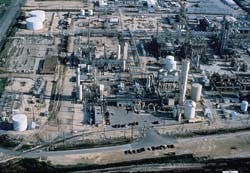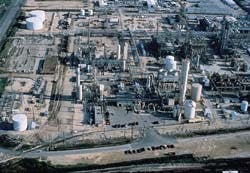A Texas project illustrates the benefits of integrated gasification
Jack PhilcoxPraxair Inc. HoustonGary W. FennerPraxair Inc. Tonawanda, N.Y.Gasification can be an attractive option for converting a variety of petroleum feedstocks to chemicals. Natural gas is commonly used to produce acetic acid, isocyanates, plastics, and fibers. But low-cost, bottom-of-the-barrel feeds, such as vacuum resid, petroleum coke, and asphaltenes, also can be used.
In any case, gasification products include synthesis gas, carbon monoxide, hydrogen, steam, carbon dioxide, and power. The more a gasification facility is integrated with utilities and other non-core operations of a production complex, the more economical the products are for all consumers.
Gasification
Gasification is a partial-oxidation process for converting various hydrocarbons to clean synthesis gas for the production of electric power, chemicals, fuels, fertilizers, and industrial gases. Gasification technology has reached a state of demonstrated maturity that makes it an attractive precursor for many chemical reactions. It allows the production of a variety of chemicals at locations, in quantities, and at costs that previously were inconceivable.The products that result from partially oxidizing hydrocarbon feeds are the basic raw materials for the synthesis of many petrochemicals and agricultural chemicals. Gasification facilities now produce:
* Syngas, carbon monoxide, and hydrogen for chemical reactions
* Hydrogen for chemical and refinery processing
* Hydrogen, nitrogen, and carbon dioxide for fertilizer manufacturing
* Syngas for energy production.
The gasification of natural gas provides several products that are raw materials for manufacturing acetic acid and oxo-alcohols. The same raw materials can be produced by gasifying heavier hydrocarbon feedstocks; however, these lower-value feeds can play a far more vital role.
In areas where they are available in substantial quantities and with a long-term, reliable supply, the gasification facility can become a hub for the development of a large petrochemical complex. Gasification of heavier hydrocarbons can consume environmentally undesirable feedstocks to produce additional products and utilities at costs that make these complexes technically and economically viable.
Gasification feeds
World demand for the products of gasification can be met using a variety of feeds, as shown in (Fig. 1[16,021 bytes]).Lower-value feeds can be gasified to produce myriad products at relatively low costs. Where low-value feeds are not economically viable, higher-value feeds such as natural gas can be gasified to provide vital products.
In addition to handling a variety of feeds, the gasification process is flexible enough to accommodate feed streams with less-than-optimum characteristics, and still provide products that meet the requirements of the downstream processes.
Natural gas
Natural gas is a simple hydrocarbon that is easily gasified. It is commonly used as a gasification feed in both the petrochemical and fertilizer industries.In most applications, natural gas must be compressed before it is fed to the gasifier. The primary factor in determining the operating pressure is the pressure required for making the end products.
If syngas is supplied to either a chemical production or power generation facility, those process requirements will influence the gasifier operating conditions. Likewise, if hydrogen is distributed via a pipeline network, the determining factor is the operating pressure of the pipeline, which is set to satisfy the needs of the various customers and to provide pipeline ballast.
Another issue in selecting the gasifier operating pressure is the pressure of the natural gas. In general, the preference is to use natural gas without compression, for both simplicity and reliability. In a typical project, a process study is conducted to determine the most cost-effective operating pressure, taking into account equipment sizes, product requirements, utility consumption, and feedstock availability.
The gasification process uses a refractory-lined vessel, in which the natural gas and an oxidant are mixed and partially combusted. The natural gas and oxidant often are preheated before they enter the gasifier to reduce the required oxidant flow rate. The resultant reaction is carried out at elevated pressure and temperature, and yields a syngas mixture comprising hydrogen, carbon monoxide, carbon dioxide, methane, and inerts.
Two basic gasifier concepts have been used successfully in natural gas service: the quench mode and the syngas cooler mode (Fig. 2 [23,822 bytes]).
In the quench mode, the hot gas exiting the reactor chamber is contacted with water via a quench ring. It is then immersed in water in the lower part of the gasifier vessel. The syngas is cooled by direct contact; it then exits the gasifier saturated with water and enters the carbon scrubber for soot removal.
Although this concept is thermally inefficient in natural gas service, it provides an effective mechanism for introducing water into the mixture. The water then can be used in promoting the water-gas shift reaction to maximize production of hydrogen.
The quench mode is commonly used with heavy hydrocarbon feeds to provide a means of handling the issues associated with increased formation of carbon.
In the syngas cooler mode, the hot gas exiting the reaction chamber is sent to a syngas cooler, which produces high-pressure, saturated steam. The cooled syngas exiting this unit can be cooled further before it enters the carbon scrubber for final soot removal.
The syngas cooler is specifically designed to meet the conditions of high thermal gradients, and to handle soot. Only a few equipment suppliers are capable of providing a reliable design for this type of exchanger.
This arrangement maximizes heat recovery, which can be an important feature, depending on the value of the steam produced. The production of syngas for carbon monoxide is ideally suited for this processing approach, because it is not necessary that the syngas contain water for the water-gas shift reaction.
Light hydrocarbons
Various offgases-which can include ethane, propanes, and butanes-also can be used as gasifier feeds. These light hydrocarbon feeds are available in integrated petrochemical complexes, petrochemical plants, and refineries.Gasification of these streams from chemical or refinery processes provides a beneficial way of disposing of environmentally undesirable materials and improving the environmental performance of the whole complex.
Various feedstocks also can be used to accommodate seasonal variations in demand for chemicals or fuels; for example, butanes could be gasified when inventories exceed demand.
Heavy hydrocarbons
In many locales around the world, natural gas is not readily available. Alternative feeds for gasification include:* Other gaseous feedstocks, including refinery and chemical plant offgas streams
* Distillate, heavy residues, and asphalts
* Orimulsion, coals, and petroleum cokes.
As a feedstock gets heavier, carbon formation increases, and the product stream from the gasifier can require more rigorous processing. The carbon can be removed in a scrubber and recycled to the gasifier, or removed in the scrubber water and sent for waste water treatment.
The viability of gasification projects will depend on the perceived values of the fuels processed, and the ability to optimize marketing of the gasification products to consuming industries.
Feed, product H/CO ratio
The ratio of hydrogen to carbon monoxide is influenced by the carbon-to-hydrogen ratios in the feed. This can be an advantage if a large quantity of feed is required and the desired product is carbon monoxide or syngas.The heavier the hydrocarbon, the lower the ratio of hydrogen to carbon monoxide tends to be. The approximate hydrogen-to-CO ratios in the gasification products of common feeds are:
* Natural gas, 1.75
* Naphtha, 0.94
* Orimulsion, 0.92
* Vacuum resid, 0.83
* Petroleum coke, 0.61.
Producing a suitable ratio of hydrogen to CO is more important in the petrochemical industry than in the refining, fertilizer, or power industries. Many chemical processes employ gasification because it provides a favorable ratio of hydrogen to carbon.
Ratios typically range from pure CO for acetic acid to a 2:1 ratio for methanol. The requirements for these processes can be met by adjusting the carbon ratios by recycling, adding carbon dioxide, or doing both.
In refineries, hydrogen can be extracted for hydrotreating and the remaining syngas used to make power and steam. In the fertilizer industry, hydrogen and by-product nitrogen are the products of choice, with CO2 a consideration for urea production. In this case, gasifying a low-value feed from a refinery to make an agricultural product could be attractive to both the refiner and the ammonia manufacturer.
In a petrochemical complex, where multiple products are required for multiple processes, hydrogen and carbon monoxide are the basic building blocks for chemicals such as acetic acid, oxo-alcohols, and phosgene. Integrating the feedstock and energy needs of the participating industries is essential to making these developing complexes economic realities.
Texas City project
The Texas City Gasification Project-designed, constructed, owned, and operated by Praxair Inc. and Texaco Inc.-is an integrated gasification facility.
By combining this new gasification facility with existing Praxair air separation and cogeneration plants, the overall complex provides the basic framework for an industrial gas utility island.
This gasification facility started up in June 1996. It processes natural gas and produces multiple products (Fig. 3 [13,339 bytes]).
The Sterling Chemicals Group manufactures acetic acid, oxo-alcohols, and other chemicals at its facility in Texas City, Tex. Sterling was considering expanding its facility and solicited competitive bids for the supply of carbon monoxide from third-party industrial gas suppliers.
The bid responses included steam methane reforming, autothermal reforming, and gasification schemes. The Texaco Gasification Process, which is used in more than 50 operating gasification plants, was selected to produce the carbon monoxide from natural gas.
The Sterling complex also uses blend gas and hydrogen for oxo-alcohol production, and has an appetite for by-product steam. Adjacent to the Sterling facility, Praxair has a 1,500 ton/day air separation unit, which provides atmospheric gas products into Praxair's Houston Ship Channel supply network.
The site also includes a 42-mw cogeneration facility operated by Praxair and Sterling as a joint venture. Excess hydrogen from the gasification facility feeds directly into Praxair's 170-mile hydrogen pipeline system.
A flow diagram of the Texas City Gasification Project is shown in (Fig. 4 [22,207 bytes]).
Natural gas, received via a commercial pipeline, is compressed, then preheated prior to entering the gasifier. Oxygen from the oxygen supply pipeline is compressed and modestly heated before being introduced into the gasifier with the natural gas.
The gasifier produces a gas stream consisting primarily of hydrogen, carbon monoxide, and carbon dioxide. This hot gas enters a syngas cooler, where it is cooled, and high-pressure, saturated steam is generated.
The gas is further cooled before entering an acid gas removal system, where the CO2 is removed and recycled back to the gasifier. This maximizes the recovery of carbon molecules for CO production.
The syngas stream is dried and fed to a cryogenic separation unit, or "cold box." The CO is separated from the hydrogen, compressed, and then sent to Sterling for use in manufacturing acetic acid.
Hydrogen from the cold box flows into a pressure swing adsorption (PSA) system, where it is purified. The pure hydrogen stream then enters Praxair's hydrogen pipeline.
Portions of the product hydrogen and carbon monoxide streams are diverted for blending before being delivered to Sterling's oxo-alcohol plant. The tail gas from the PSA is recycled to recover additional hydrogen.
The Texas City complex is a good example of a production "enclave" made possible by a multiple-product industrial gas complex. A large-scale air separation plant provides incremental oxygen to the gasification process, oxygen and nitrogen to the Praxair pipeline networks, and argon for merchant customers.
A pipeline for exporting co-product hydrogen from the gasification plant is also a part of the complex. Although this project was developed in stages, the end result is what Praxair calls an "industrial gas utility island."
World-scale complex
Where the Texas City complex illustrates the development of a simple, integrated complex, (Fig. 5 [18,877 bytes]) depicts a more complex integration-a world-scale industrial gas utility island. The term "industrial gas utility" suggests that the gasification process provides a continuous, reliable supply of resources for a variety of processes that produce a host of products.Resources available from the gasification facility could include:
* Syngas, carbon monoxide, hydrogen, carbon dioxide
* Power, steam
* Oxygen, nitrogen, argon, compressed air, cooling water
* Sulfur, slag.
The utility island concept requires investment by a business entity or entities to produce products that are shared by many consumers. The products can be provided at a low cost because of the economies of scale.
This concept is particularly attractive in those markets where raw materials such as natural gas are not available at a low cost, but heavier hydrocarbon feeds are. Examples of such product availability are vacuum resid feeds in Italy, and asphaltenes, coke, and coal in the Pacific Rim.
This process starts with securing a low-value hydrocarbon product such as coke, Orimulsion, or a vacuum resid. The feedstock preparation section of the plant is an important part of the process and one of the keys to reliable operation. It typically consists of multiple pumping systems for liquid feeds or multiple grinding and slurrying operations for solid feeds.
The feed is injected into the gasifier with oxygen to make syngas. The syngas is cooled in a quench gasifier or by hot-gas cooling, then further cooled to ambient temperature.
At this point, the cooled syngas will contain carbon dioxide and hydrogen sulfide if the feedstock contained sulfur compounds. The formation of hydrogen sulfide is significant because the stream is processed to remove elemental sulfur, not burned to produce sulfur oxides.
The syngas is processed through an acid-gas removal system, where the hydrogen sulfide and a portion of the carbon dioxide are removed, and the remaining syngas is dried. It is now available to be processed into finished products or to be consumed as an energy source.
The basic complex would gasify a heavy feedstock to make syngas for the production of electricity and steam. With this complex comes the production of sulfur and slag.
By-product nitrogen also would be available. Additional investment for the production of hydrogen, carbon monoxide, and carbon dioxide will enhance returns on investment for the complex.
Finally, with proper preliminary design considerations, compressed air and cooling water could be designed into the plant, as could an argon production facility. The successful development of markets for these products within the complex will have a financial impact that ultimately will determine the viability of the complex.
Economics
When a basic, combined-cycle power block is considered in the U.S., a 250-mw cogeneration plant costs about $175 million. Fuel costs $3.65 million/month, and capital recovery is $4 million/month. This represents a benchmark for a U.S. gasification unit.Gasifying natural gas to make steam and syngas, per se, is not economical with a feed cost based on full BTU value. The economics improve as size increases and supplemental "value-adding" products are produced. Project viability then becomes a function of the market's appetite for both the volume and the cost of the additional products.
One cost consideration is oxygen. In a small gasification project, where oxygen is generated only for the gasifier, and power costs are high, oxygen will cost as much as $60/ton to produce. Producing at a lower cost is a function of power costs, plant size, and the required product quality. The larger the capacity, the lower the investment per ton of oxygen.
In addition, as shown in (Fig. 6 [10,504 bytes]), oxygen plant costs have decreased substantially over the past few years as a result of the judicious incorporation of a series of incremental improvements in process cycles and equipment.
Justification
To illustrate the economic justification of a U.S. utility island, the case of a plant designed to gasify coke to produce 235 MMcfd of syngas will by analyzed. If 270 mw of power is to be generated, this process will use about 170 MMcfd of syngas, leaving 65 MMcfd available for refined products. At this stage, the syngas typically would contain 33 MMcfd of CO, 22 MMcfd of hydrogen, and 10 MMcfd of CO2.
The CO can be recovered in a cryogenic separation plant, from which it is available at 99+% purity. Hydrogen can be recovered in a combination membrane-PSA unit at purities of 99.9% or higher. The tail gas from the PSA unit can be returned to the syngas stream or consumed in energy production.
CO2 can be recovered, purified, and, if necessary, liquefied for commercial use in the food industry, or for chemical processing or enhanced oil recovery. It also could be recycled back to the gasifier to increase CO production. The remaining CO would go either for energy conversion or for hydrogen production through the water-gas shift reaction.
In the power-generation section, syngas fuels the turbines to produce electric power and steam. Process integration is essential for balancing mass flow in the turbine with the need to extract CO.
The economics for this case have been developed with consistent assumptions. Assuming a 95% on-stream factor, the product values would be:
* Net power @ $0.035/kw-hr, $4.8 million/month
* Steam @ $3.00/1,000 lb, $2.0 million/month
* Hydrogen @ $1.25/1,000 cfd, $1.0 million/month
* CO @ $3.00/1,000 cfd, $2.2 million/month
* CO2 @ $10/ton, $0.1 million/month.
These products represent a total value of $10.1 million/month.
(Fig. 7 [15,714 bytes]) shows the economic requirements for the project. The investment cost for a gasification system to make only power and steam cannot be justified by the revenue from those two products in a business environment where natural gas is priced between $2.00 and $2.50/1,000 cfd.
Adding either membrane and PSA units, or a shift reactor and a PSA unit, to produce hydrogen makes the investment marginal, but possible. Adding a CO separation system makes this project economically justified. CO2 adds a small enhancement.
The cost of the investment definitely impacts the costs of gasification products and the viability of the industrial gas utility island. Rigorous attention to schedule and cost must be followed once the project is defined and developed.
In the U.S., the investing environment is well known to both the project developers and lending institutions, so financing is relatively simple. In markets where power capacity is limited and a reliable supply of power is not available, the attraction for gasification is strong.
Any low-value feed that is available can be gasified, and a large part of the syngas can be used to make power and steam. A feed with no value reduces the cost of this component in the syngas to zero. Now, the challenge is to build a plant for a cost low enough to take advantage of this feedstock opportunity.
Lower value feeds, however, can increase the capital cost of a project, with sulfur handling, slag processing, and waste water treatment as the primary cost drivers. Once again, the attraction of gasification is that it can provide a multitude of high-value products that justify the investment.
These gasification utility islands are needed in less-stable markets, where natural gas is not available and rapid economic development is creating a large demand for all products-especially steam and power. The economic picture in these locales is much more compelling because of the availability of feeds and the demand for the products.
In India, where cogeneration is a consideration with naphtha at $5.00/MMBTU, the fuel value in the economic analysis increases to $9.125 million, and the total capital increases 20% to $5 million. Therefore, the cogeneration benchmark becomes $14.125 million. With this benchmark, gasifying a low-value feed and creating additional product is very attractive.
Along with this compelling economic picture, the developer finds the degree of complexity much higher outside the U.S. Factors influencing investment decisions include:
* Currency risk
* Foreign exchange
* In-country partners
* Suitable engineering companies and contractors
* Quality of operating personnel.
The feed for these projects, however, is driven by the same conditions that cause these factors to be issues. Power costs are high, and there is a strong need to exploit locally available feedstocks. Waste disposal needs are important, as are improvements in the environmental performance of utility facilities. Therefore, the development effort is more rigorous and the timing required for development is extensive.
In conclusion, the development of a gasification project is not simple or easy. Economic, political, and human-related practical issues will confront the project developer.
Creating multiple products for multiple customers is essential. If successful, gasification can be attractive for chemical production and producers. n
9528jpha.jpg
Praxair Inc. and Texaco Inc. jointly own and operate this natural gas-based gasification complex in Texas City, Tex. The unit, which started up in June 1996, produces 50 MMcfd of syngas. In addition to the gasifier, the site includes a 1,500 ton/day air separation unit and 42-mw cogeneration plant.
The Authors
Philcox
Fenner
Jack Philcox is executive director, worldwide gasification, for Praxair Inc. in Danbury, Conn. He is responsible for activity in design and construction of gasification operations. Previously, he was director of the Energy Management department at Praxair, where he was responsible for the acquisition of energy resources for the manufacture of industrial gases.
Philcox has a BS in chemical engineering from Northeastern University in Boston.
Gary W. Fenner is manager, hydrogen and gas separation process technology, for Praxair Inc. in Danbury, Conn. He provides technical and managerial support to the company's hydrogen operations. Previously, he was responsible for designing cryogenic plants for the discovery and purification of hydrogen and carbon monoxide. Fenner has a BS in mechanical engineering from the University of Wisconsin in Madison, Wis., and an MA and MBA from the State University of New York in Buffalo.
Copyright 1997 Oil & Gas Journal. All Rights Reserved.



